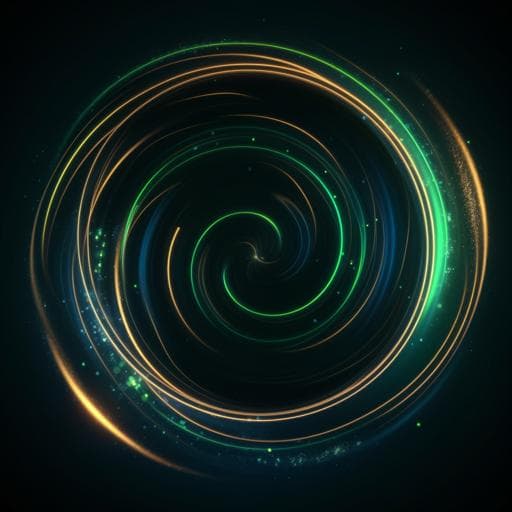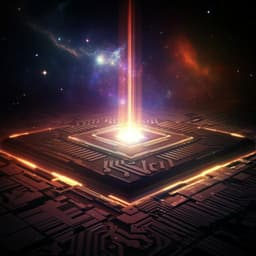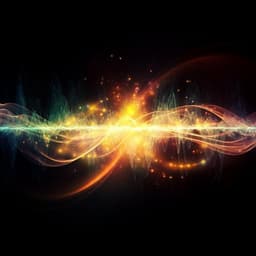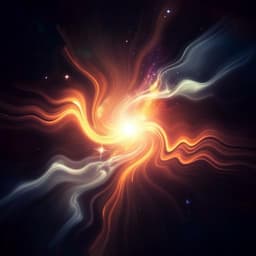
Physics
Observation of chiral edge transport in a rapidly-rotating quantum gas
R. Yao, S. Chi, et al.
This research showcases the fascinating discovery of chiral edge modes in a rapidly rotating bosonic superfluid, highlighting a compelling transition between soft and hard wall behaviors. Conducted by Ruixiao Yao, Sungjae Chi, Biswaroop Mukherjee, Airlia Shaffer, Martin Zwierlein, and Richard J. Fletcher, this study reveals insights into edge propagation dynamics and their robustness against disruptions.
~3 min • Beginner • English
Introduction
The study addresses how chiral edge modes—central to integer and fractional quantum Hall physics—propagate at boundaries and how their properties depend on wall geometry, interactions, and disorder. Conventional condensed matter probes face challenges in directly imaging edge dynamics at the magnetic length scale and in tuning boundary conditions. Ultracold atoms offer clean, controllable platforms with artificial magnetic fields, enabling direct microscopy of edge structure and dynamics. The research question is whether one can controllably inject and image chiral edge modes at the boundary of a quantum gas under synthetic magnetic fields, quantify their dispersion, speed, spatial structure, and interband gap, and determine how these properties evolve with wall sharpness and disorder. The purpose is to realize and characterize chiral edge transport in a rotating bosonic superfluid and to explore the crossover from soft-wall drift to hard-wall skipping motion while demonstrating robustness to boundary perturbations. This is important for understanding bulk–edge correspondence and for developing robust one-dimensional atomic channels analogous to electronic quantum Hall edge states.
Literature Review
Following the discovery of the integer quantum Hall effect, transport quantization was connected to both bulk extended states and edge channels, establishing bulk–edge correspondence. Edge modes are ubiquitous across topological systems including fractional quantum Hall fluids, spin Hall systems, topological insulators, photonic platforms, and exotic superfluids and superconductors. In real materials, edge disorder, interactions, and wall geometry affect edge transport, often obscuring universal behavior. Probing edge structures at the magnetic length is difficult in solid-state systems due to limited spatial resolution, restricted probe extent, and probe-sample coupling. Ultracold gases enable artificial magnetic fields via synthetic gauge fields (spin–orbit coupling, lattice phase imprinting) or rotation, the latter mapping Coriolis to Lorentz forces and introducing cyclotron frequency and magnetic length analogs. Prior atomic experiments observed chiral motion in synthetic dimensions, but systematic control of wall structure and interactions is difficult in those platforms. This work builds on rotating gas realizations in the quantum Hall regime and aims to directly inject and image edge modes with tunable boundary sharpness.
Methodology
- System preparation: A Bose-Einstein condensate of approximately 8×10^5 23Na atoms is prepared in a time-orbiting-potential magnetic trap with nearly isotropic radial confinement. The gas is brought into rapid rotation such that, in the frame rotating at the trap frequency, atoms experience an artificial magnetic field with cyclotron frequency set by twice the trap frequency. The magnetic length l_B is the natural length scale for edge modes.
- Boundary potential: Atoms are confined by an azimuthally symmetric optical wall at radius R ≈ 90 μm, created by projecting a circular mask. Because R ≫ l_B, the boundary is locally linear for edge dynamics.
- Injection of chiral edge modes: A controlled rotating anisotropy of the harmonic trap generates a static scalar saddle potential in the rotating frame with strength ε ≈ 0.125. The saddle induces drift analogous to E×B motion, driving atoms radially toward the wall and imparting an azimuthal impulse that populates edge states with finite wavevector k. This selectively injects atoms into chiral modes with positive group velocity along the boundary. The leading density wavefront corresponds to atoms with the highest injected k.
- Momentum freezing and propagation: After the wavefront propagates to a chosen azimuthal angle φ, the saddle potential is switched off to freeze the momentum distribution. The edge wavefront then moves along the wall with constant group velocity. The temporal evolution of the wavefront position is extracted by binning atoms azimuthally and fitting the rise in atom number versus time with a sigmoid to determine arrival times and speeds.
- Imaging and profile analysis: In-situ imaging is performed with a calibrated effective resolution modeled by a Gaussian (e^{-1/2} radius ≈ 670 nm). Transverse density profiles of both bulk and edge regions are obtained. The bulk profile is fitted by a Thomas–Fermi form to infer chemical potential and Landau level admixture; the edge profile is compared to theoretical ground-band edge-mode profiles convolved with the known imaging point-spread function to determine band occupancy and spatial width in units of l_B.
- Tuning wall sharpness: The optical wall is intentionally defocused to vary steepness. The projected intensity at the atoms is measured with a high-NA objective, fitted to an error function, then deconvolved by the microscope point-spread function. The resulting radial profile is fitted by a piecewise linear function to extract an effective slope, converted to a dimensionless steepness α = V0 c2/(ħ ω_c). The wall is modeled as V_wall(y)=α ħ ω_c y/l_B for y>0 and zero for y<0.
- Speed versus steepness: With the saddle kept on continuously, the wavefront’s azimuthal trajectory φ(t) is recorded for various α. The peak linear speed v at φ=π/4 is extracted from fits. A correction for the small additional inward force from the saddle at φ=π/4 is applied. Results are compared to: (i) the isopotential drift prediction v = α ω_c l_B for soft walls, (ii) the hard-wall free-particle limit v ≈ ħ k_max/m for steep walls, and (iii) a theoretical dispersion relation E0(k) obtained by solving the Schrödinger equation for the piecewise linear wall, as well as time-dependent Gross–Pitaevskii (GP) simulations following the experimental sequence.
- Band gap via skipping oscillations: A small residual population of the first excited edge band induces a dipole (center-of-mass) oscillation of the edge-mode radial position at frequency ω_osc ≈ [E1(k)−E0(k)]/ħ while the saddle is on. The edge mode radial position versus φ is fitted with a damped sinusoid to obtain the oscillation period. Using the measured peak speed v and ring radius R, the temporal oscillation frequency is inferred and compared to theoretical Δ(k)/ħ from the dispersion for varying α.
- Robustness to disorder: A repulsive Gaussian obstacle (radius ~10 l_B) co-rotating with the trap is projected at the boundary, producing a static bump in the rotating frame. Edge propagation around the obstacle is imaged and compared to GP simulations to assess backscattering and robustness.
- Theory and simulations: The single-particle Hamiltonian in Landau gauge with a piecewise linear wall is solved using Weber (parabolic cylinder) functions with boundary matching at y=0 to obtain E_n(k) for varying α, including modifications from the saddle force. GP simulations with experimental parameters (trap, wall, rotation protocol) are used to compute edge speeds and oscillation periods for quantitative comparison.
Key Findings
- Direct observation and controlled injection of chiral edge modes at the boundary of a rapidly rotating bosonic superfluid confined by an optical wall. The edge wavefront propagates unidirectionally without detectable dissipation or backscattering.
- Dispersion and speed: Measured edge-mode speeds versus injected wavevector k agree with the lowest-band dispersion E0(k) for a hard wall and approach the chiral free-particle prediction v = ħ k/m for large k. The experimental points align with theory without free parameters when accounting for energy conservation along the saddle.
- Edge-mode structure: The transverse width of the edge mode is set by the magnetic length, indicating occupation of the lowest edge band. A Gaussian fit yields FWHM ≈ 1.21(2) l_B for the edge mode. The bulk condensate profile is Thomas–Fermi with FWHM ≈ 4.8 l_B, consistent with a chemical potential μ ≈ 6 ħ ω and admixture of about six Landau levels in the bulk superfluid.
- Crossover with wall sharpness: By tuning wall steepness α (≈5 to ≈24), the edge speed exhibits a clear crossover: v ∝ α ω_c l_B for shallow walls (isopotential drift) and saturation to a constant hard-wall value v ≈ ħ k_max/m ≈ 10 ω_c l_B for steep walls. This crossover corresponds to the classical transition from E×B drift under a uniform force to skipping orbits along a hard boundary when the wall force becomes comparable to the Coriolis force (F_wall/F_Coriolis ~ 1).
- Band gap (skipping frequency): Residual excitation of the first excited edge band leads to a center-of-mass radial oscillation at frequency ω_osc = [E1(k)−E0(k)]/ħ. For shallow walls, ω_osc ≈ ω_c (bulk Landau level splitting). As α increases and k_max l_B ≳ 10, ω_osc rises above ω_c, indicating enhanced edge-band splitting due to sampling the wall onset—consistent with a quantum analogue of faster classical skipping motion near a hard boundary. The measured ω_osc matches Δ(k_max)/ħ from theory without free parameters.
- Robustness to disorder: A repulsive Gaussian obstacle at the boundary produces no discernible backscattering; atoms flow smoothly around the deformation. GP simulations reproduce the observed robustness.
- Quantitative parameters: Typical maximum injected wavevector k_max ≈ 10/l_B; ring radius R ≈ 90 μm; anisotropy strength ε ≈ 0.125; edge widths at the magnetic-length scale confirm lowest-band occupation.
Discussion
The experiments establish a clean, tunable platform to inject and image chiral edge transport in a quantum gas with synthetic magnetism. By engineering and characterizing the wall potential, the study disentangles the roles of boundary sharpness and local forces on edge dynamics. The observed speed–steepness crossover directly connects to bulk–edge correspondence: in the soft-wall limit, guiding centers drift along isopotentials with v ∝ α, while in the hard-wall limit the decoupling of position and momentum yields chiral free-particle behavior with v ≈ ħ k/m. The spatial confinement of the edge mode to ≈ l_B and its occupation of the lowest edge band demonstrate the microscopic structure of edge excitations. The measurement of the interband gap via skipping-orbit oscillations reveals how edge dispersion departs from bulk Landau-level splitting as atoms probe the wall onset, providing a spectroscopic handle on edge-band structure. Robust propagation around a static obstacle underscores the topological chirality that suppresses backscattering. Overall, the results address the central question by realizing controllable, dissipationless chiral edge transport, quantifying dispersion, speed, and band gaps, and highlighting universal behavior across soft-to-hard boundary regimes with strong agreement between experiment, theory, and GP simulations.
Conclusion
This work reports the realization and direct imaging of chiral edge modes in a rapidly rotating Bose–Einstein condensate confined by an optical boundary. It demonstrates controlled injection via a rotating saddle potential, quantifies edge dispersion and speed, and reveals a smooth crossover from soft-wall isopotential drift (v ∝ α ω_c l_B) to hard-wall chiral free-particle propagation (v ≈ ħ k/m). The edge mode’s spatial width is set by the magnetic length, indicating lowest-band occupation. Skipping-orbit oscillations provide a spectroscopic measure of the edge-band gap, evolving from the bulk Landau-level splitting to enhanced values near hard walls. Edge transport remains robust against boundary disorder, with no visible backscattering. These advances provide a versatile platform for exploring edge physics with tunable geometry and clean control.
Future directions include: systematic studies of disorder length scales and dynamics; exploration of interaction effects at the edge, such as realizing a chiral Lieb–Liniger gas; probing beyond-mean-field regimes and fractional quantum Hall analogs; and implementing robust atomic edge-state interferometers analogous to electronic quantum Hall devices.
Limitations
- The study focuses on a weakly interacting bosonic superfluid in the mean-field quantum Hall regime; strongly correlated fractional edge physics is not addressed here.
- The system is realized in a rotating frame and relies on finely tuned rotation and trap anisotropy; extending to other geometries or to fermionic systems requires additional work.
- Imaging resolution, while calibrated and sufficient for edge-mode structure, still convolves intrinsic profiles and may mask finer features of higher bands or small backscattering.
- The measured dispersion and gaps rely on modeling of the wall as a piecewise linear potential and on energy-conservation arguments in the presence of the saddle; deviations from idealization or spatial inhomogeneities may introduce systematic uncertainties.
- Residual excitation of higher bands, while useful for gap spectroscopy, indicates non-adiabaticity during injection which could complicate precise band population control.
Related Publications
Explore these studies to deepen your understanding of the subject.







